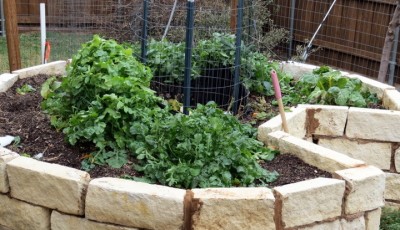|
Listen To The Article
|

Keyhole gardening captures the essence of raised bed gardens with the added bonus of a compost bin.
No matter where you live you are likely to face any number of gardening challenges, and many involve unfavorable weather conditions such as drought. While there are many kinds of gardens, one that is gaining a great deal of attention lately to combat drought conditions is known as a keyhole garden.
The keyhole gardening concept originated in Africa. The method was started by a humanitarian organization who wanted to help find a gardening style that was suitable for extremely hot and dry conditions. According to those helping with the garden project in Africa, three keyhole gardens produce enough food to feed a family of 10 for a year.
Gardeners in unforgiving climates throughout the United States such as Texas and Arizona are now catching on to the unique nature of keyhole gardening. In addition, they are taking advantage of the growing opportunities it provides.
What Is The Keyhole Concept?
Keyhole gardens capture the essence of raised bed gardens with the added bonus of incorporating a compost bin that feeds both soil and plants. Built most often in the shape of a pie, keyhole gardens usually measure 6-feet in diameter and stand at about waist height.
New Natural Fertilizer Doubles Garden Production!
They have a notch cut out as if someone has taken a slice of the pie. Furthermore, a compost basket is strategically positioned in the center of the pie with easy access from the notch. One of the best parts about these keyhole gardens is that they can be made from any number of recycled materials. The biggest plus of all is that this type of gardening style requires substantially less water than conventional gardens. Moreover, keyhole gardening has this advantage because of its shape and its utilization of a central compost basket.
Advantages Of Keyhole Gardening
Why would someone want to try keyhole gardening? Here are eight reasons:
- Makes great use of waste
- Requires no fertilization
- Requires very little water
- Can be constructed from found or recycled materials
- Requires very little maintenance
- Can be easily transformed into a winter hothouse
- You can grow a great deal of produce in a small area
- Can easily accommodate a shade cloth for sheltering summer sun
How To Make Your Own Keyhole Garden
If you have a few hours to spare, you can transform an empty spot in your landscape into an edible garden. This setup will also provide you with delicious and nutritious food that you can feel good about eating.
- Find a relatively level spot somewhere in your landscape that receives at least six hours of sunlight daily. If possible, locate the garden within close proximity to a water source. Many people set up a drip irrigation system to keep their beds moist during very dry spells.
- Measure a circle about six feet in diameter. This will define the inside wall of the garden.
- Make a notch in the circle — like a slice taken from a piece of pie. This will be how you access the compost bin in the garden. (The compost bin will be in the very center of the circle)
- Gather materials for your walls. These can be rocks, metal, logs, or any other material that will withstand the weight of the soil.
- Build the outer wall of your garden to a height of about three feet.
- Create a wire mesh tube that is about one foot in diameter and four feet high; chicken wire works best. This will be your compost tube.
- Line the inside of the walls with cardboard.
- Fill in the garden area either with soil or by layering compost. Then, add a three-inch layer of cardboard to the bottom, followed by a three-inch layer of green leaves. Next, follow this with a three-inch layer of small twigs or branches, followed by a three-inch layer of grass clippings. Finally, you should follow this with a three-inch layer of shredded newspaper or sawdust. Wet each layer as you place it.
- Fill the remaining part of the bed with rich compost and organic soil — sloping the soil away from the compost bin toward the outside edge.
- Line the bottom of the compost basket with two inches of small rock to help with drainage.
- Fill the basket with alternating layers of brown and green compostable material.
- Add compostable material to the basket to continue to feed the garden and soil.
Story continues below video
Water your garden through the compost basket and continue adding compost to it over time; the idea is to get the roots to grow toward the center.
Tips And Suggestions
- If you are expecting a lot of rain it is wise to put a cover over your compost bin so that it does not leach too quickly.
- Add clear plastic to your beds for the cooler seasons, and you can grow vegetables all year long.
- Water the center basket and bed when plants seem in need of water or when first establishing plants.
- Practice companion planting for best results.
- Mix some flowers in with your vegetables for beauty.
In conclusion, learning the concept of keyhole gardening will help you enjoy fresh vegetables even in the hottest of climates.
You may also enjoy reading an additional Off The Grid News article: Stopping Summer Garden Beetles Without Using Chemicals
Do you have keyhole gardening tips? Share them in the comments section below.
 Off The Grid News Better Ideas For Off The Grid Living
Off The Grid News Better Ideas For Off The Grid Living



